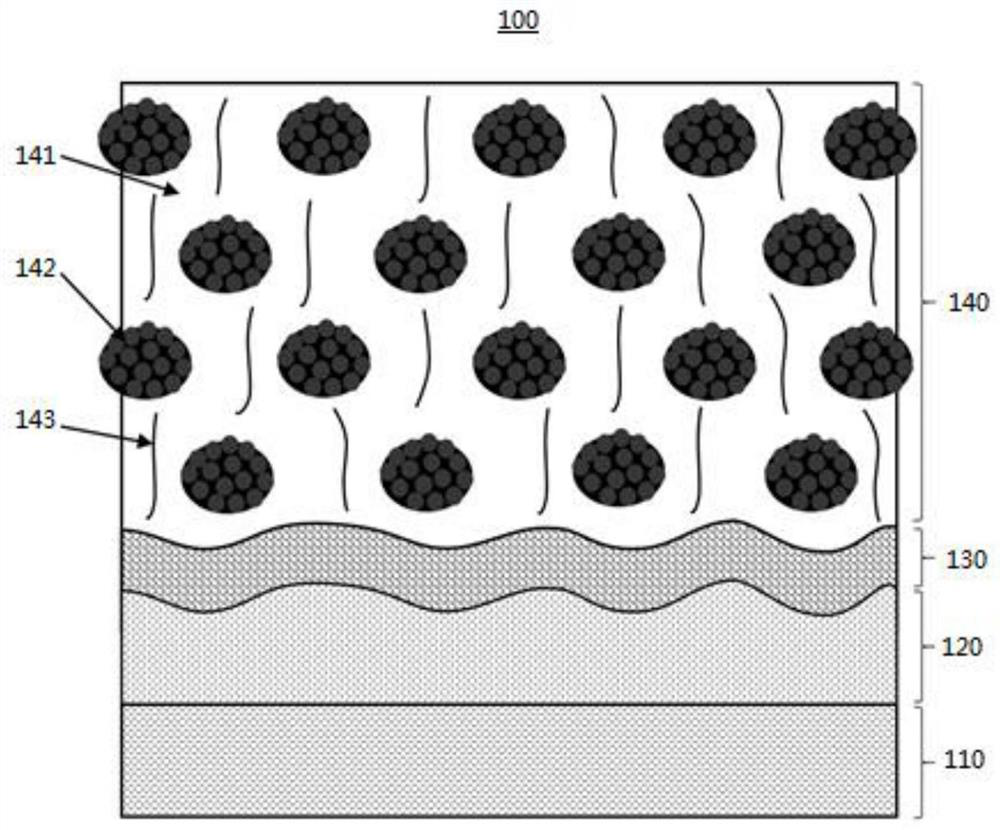Thermal barrier coating material and preparation method and application thereof
A thermal barrier coating, coating technology, applied in coating, metal material coating process, melt spraying and other directions, to reduce thermal stress, improve oxidation failure, and improve the ability to adapt to lateral deformation
- Summary
- Abstract
- Description
- Claims
- Application Information
AI Technical Summary
Problems solved by technology
Method used
Image
Examples
preparation example Construction
[0033] An embodiment of the present invention also provides a method for preparing a thermal barrier coating material, which is used to prepare the above thermal barrier coating structure, including: depositing a bonding layer 120 on the alloy substrate 110, and depositing a ceramic transition layer on the bonding layer 120 130 , forming a ceramic surface layer 140 on the ceramic transition layer 130 .
[0034] Wherein, the preparation process of the adhesive layer 120 belongs to the prior art, and will not be described in detail here.
[0035] In some embodiments, the ceramic transition layer 130 is deposited by plasma spraying, and the spraying power is 40-100 kW, so that the ceramic powder can be deposited in a completely molten state to form a dense coating. In actual operation, it is necessary to preheat the sample to be sprayed to 400-700°C before deposition.
[0036] Further, the particle size of the ceramic powder used in the ceramic transition layer 130 is 15-45 μm, an...
Embodiment 1
[0048] This embodiment provides a method for preparing a thermal barrier coating material, which is formed as figure 1 The thermal barrier coating structure shown in , specifically includes the following steps:
[0049] (1) The alloy matrix 110 is made of a cobalt-based superalloy whose material is GH5188, with a thickness of 6mm.
[0050] (2) Depositing the bonding layer 120 on the alloy substrate 110: the bonding layer 120 is formed on the alloy substrate 110 by using NiCrAlY material by plasma surface spraying, and the thickness is controlled to be 120 μm.
[0051] (3) Deposit the ceramic transition layer 130 on the adhesive layer 120: first preheat the sample to be sprayed to about 500° C., use a fused and crushed yttria-stabilized zirconia powder with a particle size of 10-45 μm, and use high-power The deposition is realized in the form of complete melting under the plasma spraying state, the spraying power is controlled to 45 kW, and the thickness of the ceramic transit...
Embodiment 2
[0054] This embodiment provides a method for preparing a thermal barrier coating material, which is formed as figure 1 The thermal barrier coating structure shown in , specifically includes the following steps:
[0055] (1) The alloy matrix 110 is made of a cobalt-based superalloy whose material is GH5188, with a thickness of 6mm.
[0056] (2) Depositing the bonding layer 120 on the alloy substrate 110: the bonding layer 120 is formed on the alloy substrate 110 by using NiCrAlY material by plasma surface spraying, and the thickness is controlled to be 120 μm.
[0057] (3) Deposit the ceramic transition layer 130 on the adhesive layer 120: first preheat the sample to be sprayed to about 500° C., use a fused and crushed yttria-stabilized zirconia powder with a particle size of 10-45 μm, and use high-power The deposition is realized in a completely molten form under the plasma spraying state, the spraying power is controlled to 45kW, and the thickness of the ceramic transition l...
PUM
| Property | Measurement | Unit |
|---|---|---|
| thickness | aaaaa | aaaaa |
| thickness | aaaaa | aaaaa |
| particle diameter | aaaaa | aaaaa |
Abstract
Description
Claims
Application Information
 Login to View More
Login to View More - R&D
- Intellectual Property
- Life Sciences
- Materials
- Tech Scout
- Unparalleled Data Quality
- Higher Quality Content
- 60% Fewer Hallucinations
Browse by: Latest US Patents, China's latest patents, Technical Efficacy Thesaurus, Application Domain, Technology Topic, Popular Technical Reports.
© 2025 PatSnap. All rights reserved.Legal|Privacy policy|Modern Slavery Act Transparency Statement|Sitemap|About US| Contact US: help@patsnap.com


